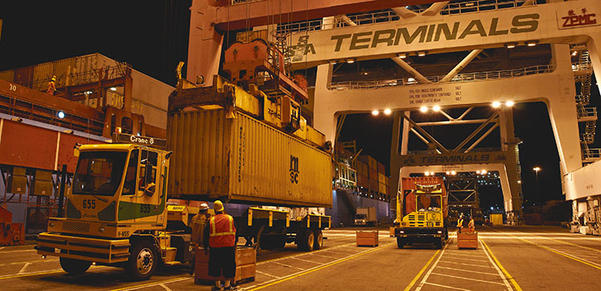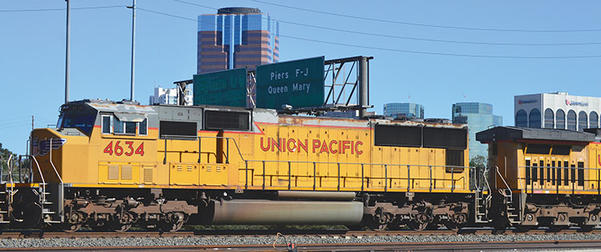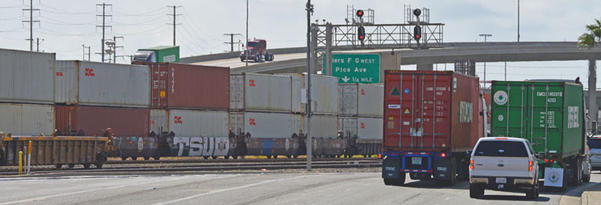Last summer, Gov. Jerry Brown issued an executive order mandating that state agencies work with freight industry stakeholders and business interests to create an action plan to move the freight sector towards cleaner operations while growing its economic competitiveness. Agencies including the California State Transportation Agency, the California Air Resources Board, the California Energy Commission and others collaborated with industry to produce the California Sustainable Freight Action Plan, which was released in July.
The 30-page document is essentially a framework for moving forward with attaining the goals laid out by the governor’s executive order.

The California Sustainable Freight Action Plan, released in July, calls for 100,000 freight vehicles and equipment capable of zero emission operation to be deployed by 2030. (Photograph provided by the Port of Long Beach)
The plan lays out a vision for moving toward a more sustainable and economically viable freight transportation system through a series of guiding principles and goals. Some such principles include “ensuring net reductions in regional freight pollution,” investing strategically to improve travel times and reduce congestion, applying innovative and green technology to optimize freight movement and more.
Examples of concrete goals include deploying more than 100,000 freight vehicles and equipment capable of zero emissions operations by 2030 and improving the efficiency of the state’s freight system by 25% “by increasing the value of goods and services produced from the freight sector, relative to the amount of carbon it produces, by 2030.”
Also included is a goal to establish targets for increasing the freight sector’s competitiveness and “future economic growth” based on metrics established by industry experts and economists.
Industry stakeholders told the Business Journal that, overall, they are satisfied with the objectives of the plan and their inclusion in its development. But they are concerned that there are not yet metrics to ensure that the freight sector’s competitiveness will be boosted and not harmed by strategies for reducing greenhouse gas emissions.
“The approach was good. We had a lot of stakeholder meetings over the past year and a half,” Chris Shimoda, policy director for the California Trucking Association, said. “I think the process was careful and measured, and inclusive of every stakeholder’s commentary no matter where they happen to fall.”

About 40% of the nation’s goods flow through the ports of Long Beach and Los Angeles. As a hub for the freight sector, the ports worked with the state to ensure that their own goals for environmental sustainability aligned with the Sustainable Freight Action plan. (Photograph by the Business Journal’s Larry Duncan)
While the plan outlines a vision for transitioning to zero emission technologies, what’s not clear is how that transition might impact the freight sector, according to Shimoda. “Would California trucking companies, for instance, be competitive against the other states if we’re running zero emission equipment?” he asked. “Do we have the tools, the data, the analysis that allows us to determine that? I think in the final document you’ll see that the answer is no.”
Mark Hirzel, past president and current chairman of the Los Angeles Customs Brokers & Freight Forwarders Association, is also concerned about establishing metrics moving forward. “What we have been waiting for is a metric which measures the economic competitiveness [of the industry],” he said.
“There is nothing that I would say that we’re against as long as we can remain economically competitive,” Hirzel said. “The problem is that all of these things cost money,” he noted, adding that he is concerned the cost for transitioning to cleaner equipment will fall primarily on private industry.
Mike Jacob, vice president of the Pacific Merchant Shipping Association (PMSA), was part of industry groups involved with the formation of the plan. While he said the plan’s goals are attainable, he would have preferred it had included more detail with respect to improving the freight sector’s economic competitiveness.
“There is a large swath of the plan which is really all fundamentally based on the linchpin of economic competitiveness,” Jacob said. “But the actual next steps for economic competitiveness have yet to be fleshed out. It’s something that the plan identifies as something that the state needs to work on.”
While PMSA had requested that specific direction for strategies related to the maritime industry be included in the plan, such details were not present in the final document, Jacob said. But, he noted, that does not necessarily mean such directions won’t be developed moving forward.
“The process that they employed was probably about as good as you’re going to get,” Jacob said of the state’s strategy in developing the plan. “We never felt we did not have access to the process as industry. We attended every possible meeting we could, and there were a lot of them.” Meetings of the California Freight Advisory Committee, which includes industry stakeholders like PMSA, will continue as strategies for the plan are fleshed out, he noted.

State agencies have created an action plan for boosting the competiveness of the freight sector while making it more environmentally sustainable. (Photograph by the Business Journal’s Larry Duncan)
In January 2017, collaboration between industry and regional/local agencies to develop funding strategies for investing in transportation assets, including clean vehicles and equipment, will begin, according to a timeline included in the plan.
By July 2017, state agencies will create strategies for three pilot projects. These include developing a dairy biogas-sourced biomethane fueling facility for use by freight vehicles, advanced technology for truck corridors in Southern California, and advanced technology corridors at ports of entry on the California-Mexico border.
The Port of Long Beach (POLB) is aligning its future operational and environmental strategies with the Sustainable Freight Action Plan, according to Heather Tomley, the port’s director of environmental planning. For example, POLB and the Port of Los Angeles were waiting for the Sustainable Freight Action Plan to be released before moving forward with an update of their Clean Air Action Plan. The plan outlines goals for air emissions reductions and strategies to achieve those goals.
“I would say, for the most part, the things that they are proposing really are consistent with the types of strategies that we are proposing going forward as well,” Tomley said.
The port is also developing a concept called Energy Island, which would identify self-sustaining energy sources to power the port outside of existing electrical grids. In the development of CAAP and Energy Island, as well as through its ongoing supply chain optimization efforts, Tomley said the port hopes to take advantage of funding opportunities by aligning with the Sustainable Freight Action Plan’s goals. “We want to make sure our strategies are in alignment with that so that we can capture as much of that funding for our local operators as possible,” she said.
“We do have good relationships with the agencies that have been involved with the sustainable freight action plan, and we intend to continue to work with them closely as they start shaping up the specific strategies,” Tomley said.
A spokesperson for the California State Transportation Agency said the agency is currently working through actions in the plan and is remaining engaged with stakeholders. Meetings continue to move the process forward, the spokesperson said.
